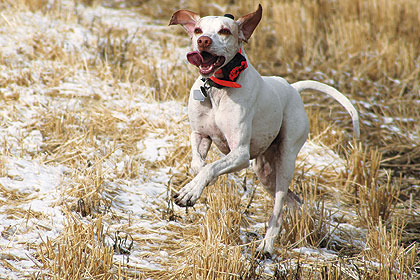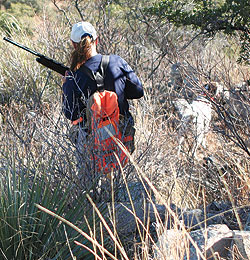Prevention and common sense will help prevent losing your best friend.
By Dave Carty
We'd made a sweep of the wheat field, found the two coveys of Huns exactly where my friend Wil had predicted they'd be, and enjoyed some nice dog work from my Brittany, Powder, and Wil's diminutive little Brit, Annie. Our dogs hunt well together; Annie had lived in my kennel the previous summer while I schooled her in the niceties of hunting with humans -- returning on the whistle, retrieving, steadiness to wing and shot, the whole nine yards.
 The wider your dog ranges, the greater the possibility of him becoming lost. Running him with an e-collar plus a regular collar carrying identification tags makes good sense. |
But it was a credit to her innate intelligence and drive, not my training, that she'd become something of a canine phenom since leaving my place and beginning her career as a working bird dog. So as the two of us were climbing a fence and a few feet from my truck, the dogs working the last rows of wheat behind us, it never crossed my mind that she might get it into her head to turn and run the other way. But she did, and when Wil and I turned around, Annie was gone.
Wil whistled but she didn't respond. He turned on the beeper of her collar but wherever she was, she was now out of earshot. Then Wil and I both began whistling, notes of panic beginning to edge into our shrill trilling. For the next half hour we whistled, shot our guns and yelled her name, all to absolutely no effect.
The worst of it was that neither of us had the slightest idea where she'd gone. With miles of sagebrush and wheat around us, we didn't even know where to begin looking. Finally, blessedly, we heard a faint beep, then another. A few seconds later, Annie was back, happy as a clam, apparently unconcerned about all the anguish she'd caused the two of us. To this day, we have no idea where she went, or why.
If any of this sounds familiar -- and if you've owned birds dogs for long, it undoubtedly does -- then you don't need me to remind you of how heart-wrenching losing your dog can be. So what follows is a good news/bad news deal: While there's nothing you can do to completely eliminate the chance of losing your dog, there's plenty you can do to lessen the chance that it will happen.
The first precaution -- no surprise here, coming from a dog trainer -- is basic obedience. Does your dog return reliably when you whistle? Think about it. By "reliably," I mean that the dog stops whatever it is doing and returns to your side (or at least runs toward you) with no more than two blasts of your customary whistle recall command. That may sound like a no-brainer, but if the dozens of dogs I've seen who ignore their owner's recall whistles are any indication, it's apparently not as simple to teach as it sounds.
How do you get past that? By adding distractions to your training program. Start with simple things, like training the dog in new surroundings. Then progress to training the dog with other dogs, around livestock, whatever you can think of. Start with a check cord and, assuming he's been collar conditioned, progress to an e-collar. Finally, keep the e-collar on and work on the recall command on actual hunts. Whistle once, then correct your pup if he doesn't respond immediately.
 Close-ranging dogs in tight cover might seem unlikely to become lost, but it can happen. |
This is a program that never ends; my dogs always wear e-collars on hunts and always get corrected if they don't respond to the whistle immediately (which they still choose not to do, God love 'em). You may be surprised at how little you use the collar, but your dog will know he's wearing it, and that knowledge will make him considerably more inclined to respond.
Finally, buy a whistle that makes some serious noise. Voice commands and horn whistles are for Labs and spaniels, not pointers that are running into the teeth of a prairie gale 300 yards away or crashing through dense popple thickets in the swamps of Wisconsin. I use a medium-sized Acme Thunderer, which is so loud I have to cup my hands around it to protect my ears. Trust me, you'll feel a lot better if you're sure your dog can hear you.
I'm also a believer in microchipping my dogs, although I have to go on faith that, should any of them become lost, they'll wind up in a shelter or vet's office that has a scanning device. Still, chips are cheap, and to my way of thinking the extra insurance is worth the cost.
Even cheaper, and far more valuable, is an everyday I.D. collar with tags or your name and number engraved on a plate and riveted to it, yet I'm amazed at how many people fail to take this simple precaution. Invariably, their excuse is that the dog is never out of their sight, but dogs are amazingly adept at slipping away in the two or three seconds it takes to turn your attention elsewhere, and that's invariably when they get lost.
Why take the chance? You can buy a collar and tags that will last your dog the rest of his life for 12 or 13 bucks. Spend the money. Thousands upon thousands of dogs are reunited with their owners every year when kind-hearted strangers take down the info on a forlorn stray's tags and make a quick phone call.
The next piece of advice is something that may or may not apply to you. I used to preach that, at least for open-country bird dogs, range wasn't an issue. As long as the dog was staunch and responded to my commands, I didn't care how far out he hunted.
But I've changed my mind on that, for reasons I don't have the space to go into here (but will in a future column). Suffice it to say that range does matter, at least to me. Don't get me wrong -- I'm not advocating boot polishers -- I'm simply saying that where I used to enjoy hunting over dogs that would punch out to 500 or 700 yards on the prairies, now I'd prefer that they operate closer to 200. The upshot has been that, the more I'm in visual contact with my dogs, the less chance there is that they'll wander off and get lost.
Finally, one thing stands head and shoulders above all other lost-dog preventatives: Garmin's Astro 220 GPS. GPS units are the biggest innovation in canine training tools since the invention of e-collars decades ago. With an Astro strapped to your vest, knowing where your dog has been, where he is, and where he's going are under your fingertips. By installing a map chip, I can correlate his position in relation to the local terrain. And not coincidentally, when I've got my dog safely back by my side it will tell me how to find my way back to
my truck.
I wasn't an instant convert. But several years ago, while on a chukar hunt in a remote section of Oregon, my setter Scarlet ran away. As with Annie, one minute she was casting comfortably before me, the next she simply vanished. For all I knew she might have dropped into a hole in the earth, a distinct possibility in that immense, broken country.
Fortunately, she hadn't. She eventually found her way back to my truck, and 45 minutes later, that's where I found her, as happy to see me as I was to see her. But the incident scared me badly, and I swore I'd do anything I could to prevent its happening again. Not long after, I got my first Astro 220.
The Astro isn't foolproof, and like all computers, it suffers from occasional bugs. My unit periodically loses contact with my dogs, and if I go too long without calibrating the internal compass, it gives me false readings. If you're an impatient and technological illiterate like me the Astro can be intensely frustrating to troubleshoot on your own, which is the reason for tech support, I suppose. But over the last couple seasons I've learned to head off most of the unit's problems before they crop up, and the security that comes from knowing where my dog is is priceless.
Had Annie been wearing an Astro that day, we'd have known exactly where she'd gone, and even if she'd run out of range of the unit, we'd have at least known where to begin looking for her. These days, I'd rather run one of my dogs without an e-collar or I.D. collar than without her GPS unit.
Nothing you can do, and no product you can buy, will guarantee that your dog will never again become lost. But if you've ever lost a dog for a few minutes, an hour, or a day, you'll learn what all of us who have been through that self-doubt and misery come to realize: no training in the future will be too much work, no training implement too expensive, to prevent it from happening again.






